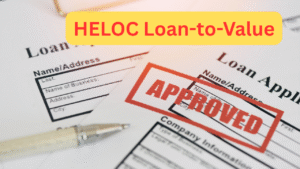 HELOC Loan-to-Value: How Much Equity Can You Tap?
HELOC Loan-to-Value: How Much Equity Can You Tap?
A Home Equity Line of Credit (HELOC) is one of the most flexible ways to borrow against your home’s value. But how much can you actually access? That depends on your HELOC Loan-to-Value (LTV) ratio—a key metric lenders use to determine your borrowing limit.
In this post, we’ll break down how HELOC LTV works, what typical limits look like, and the pros and cons of borrowing at higher LTV thresholds.
📊 What Is Loan-to-Value (LTV) in a HELOC?
Loan-to-Value (LTV) measures the percentage of your home’s appraised value that’s tied up in debt. For HELOCs, lenders typically allow a combined LTV (CLTV) of 80–90%, meaning your total mortgage + HELOC balance can’t exceed that percentage of your home’s value.
HELOC Loan To Value Formula
Combined LTV = (Mortgage Balance + HELOC Limit) ÷ Home Value × 100
Example Scenario
| Item | Amount |
|---|---|
| Home Value | $500,000 |
| Mortgage Balance | $350,000 |
| Max CLTV (90%) | $450,000 |
| HELOC Limit | $100,000 ($450K – $350K) |
📈 Typical HELOC Loan To Value Limits by Lender Type
| Lender Type | Max CLTV | Notes |
|---|---|---|
| Traditional Banks | 80–85% | Conservative underwriting |
| Credit Unions | 85–90% | More flexible for members |
| Online Lenders | Up to 90% | May offer promotional terms |
| Private Lenders | 90%+ | Higher risk, higher rates |
✅ Pros of Higher HELOC LTV
1. Access More Equity
Borrowing up to 90% CLTV gives you more cash for renovations, debt consolidation, or investments.
2. Avoid Refinancing
Keep your current mortgage rate and terms while unlocking equity.
3. Flexible Draw Period
HELOCs typically offer 5–10 years of interest-only payments during the draw phase.
4. Lower Rates Than Credit Cards
Even at higher LTVs, HELOC rates are usually lower than unsecured debt.
5. Tax Deductible Interest
If used for home improvements, HELOC interest may be deductible (consult a tax advisor).
❌ Cons of Higher HELOC LTV
1. Reduced Equity Cushion
Borrowing close to your home’s value leaves little room if property prices fall.
2. Higher Interest Rates
Lenders may charge more for higher-risk loans.
3. Risk of Overleveraging
Easy access to funds can lead to overspending, especially with interest-only payments.
4. Stricter Qualification
Expect higher credit score and income requirements for 90% CLTV approvals.
5. Foreclosure Risk
HELOCs are secured by your home—missed payments could lead to foreclosure.
🧮 Quick HELOC Loan To Value Calculator
HELOC Loan-to-Value Calculator
🧠 When to Use a HELOC at Higher LTV
- You need large funds for renovations, tuition, or medical expenses.
- You have strong credit and income stability.
- You’re confident in local property value trends.
- You want to avoid refinancing your mortgage.
🛑 When to Be Cautious
- You’re planning to sell your home soon.
- You’re already carrying high debt.
- You’re uncomfortable with variable interest rates.
- You lack a clear repayment strategy.
❓ HELOC Loan to Value: FAQs
- What’s the max LTV for a HELOC?
Most lenders cap it at 80–90%, depending on credit and income. - Can I get a HELOC with 100% LTV?
Rarely. Some private lenders offer it, but with high rates and risk. - Is HELOC interest tax-deductible?
Yes, if used for home improvements and you itemize deductions. - Does a HELOC affect my credit score?
It can—new credit lines and utilization may impact your score. - Can I refinance a HELOC later?
Yes, many lenders offer fixed-rate conversion or refinancing options.